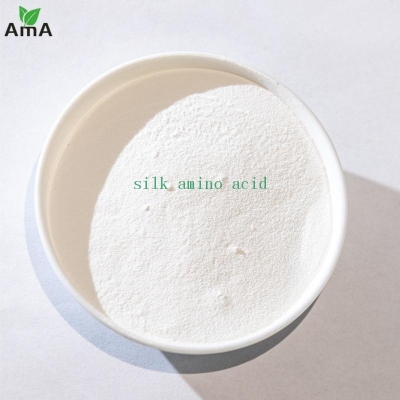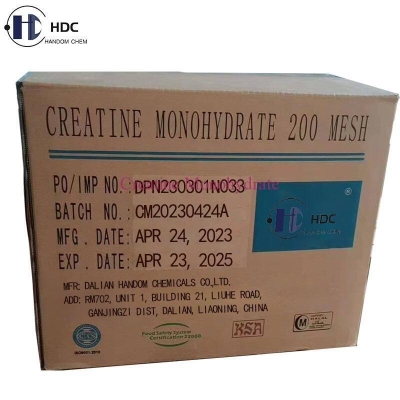Amino acid manufacturing industry is facing transformation, circular economy low-carbon environmental protection is the way out
-
Last Update: 2020-07-02
-
Source: Internet
-
Author: User
Search more information of high quality chemicals, good prices and reliable suppliers, visit
www.echemi.com
China is a large country of amino acid production, but, while the amino acid industry in China is developing rapidly and the scale of products is expanding, the pollution of the environment and the consumption of resources are increasingIt is imperative for the amino acid manufacturing industry to adhere to the circular economy, promote cleaner production and reduce energy consumptionat present, China's amino acid production enterprises have reached nearly 100, the total output of more than 3 million tons, of which, bulk amino acid products glutamate and its salts annual output of 2.2 million tonsThe annual output value of amino acid industry has grown to more than 40 billion yuan, accounting for more than a quarter of the total output value of China's fermentation industryFrom January to November 2010, China's amino acid industry market reached 60,385 million yuan, up 22.8% YoY, and the total industrial output value of the industry reached 59.961 billion yuan, up 20.2% YoYChina's amino acid production has reached the world's first, the main varieties are basically complete, but too much energy consumption, low economic efficiency, energy conservation and emission reduction situation is seriousto glutamate (MSG) as an example, MSG belongs to the low-level industry, glutamate is the world's largest amino acid varieties, in recent years, the annual production of MSG has been close to 2 million tons, the output value of up to 20 billion yuan, in 2006 has reached 13.4 billion yuanBut it consumes too much foodAt present, the largest fermentation tank of glutamate is 800 cubic meters, most of its production raw materials are high starch content of food crops, so the production of glutamate needs to consume too much rice in the south and corn in the north, glutamate extraction process will also produce a large number of high concentrations of wastewater, because the treatment of fermentation wastewater technology has not yet made a fundamental breakthrough, so the wastewater treatment process will also generate waste gas pollutionconsumean energy of about 1.9 tons of standard coal per ton of MSG, with an annual consumption of about 3.496 million tons of standard coal, about 90 tons of fresh water and about 166 million tons of fresh water per year, and about 2.35 tons of corn consumed, with an annual consumption of about 4.324 million tons of cornIt can be seen that the amino acid industry energy consumption, water consumption and wastewater emissions are highininer in the fermentation industryAlthough China is a large amino acid industry, but by no means an industrial power, the comprehensive utilization rate of resources is also very lowChina's amino acid industry resources comprehensive utilization level is not high, at present some developed countries raw material utilization rate has reached 99%, and China's average level in 95%, most enterprises are starch as raw materials for fermentation production, raw materials in 30% of non-starch by-products in addition to germ oil, the rest processed into feed, no deep processing production of high value-added productsChina's amino acids also can not control the pricing power, once China can produce new products, prices quickly felldue to the excess capacity of lysine in amino acids, the price has been reduced from 50,000 yuan / t to 20,000 yuan / t, has been unprofitable, the earliest Sichuan flavor of the company has closed the lysine production line, and finally declared bankruptcyIn addition, there are tons of amino acids: Tianmen dosine and phenylalanine, mainly used to make dipeptide sweetener aspartame (APM), but after China can produce phenylalanine and APM, prices began to fall several timesindustrial-grade phenylalanine in 1995 is 200,000 yuan / t, is now 65,000 yuan / t, APM from the previous 500,000 yuan / t to today's 150,000 yuan / t, most of the products are exported at low prices Other small varieties of amino acids and deep processing of new products such as polylysine, glutamate, polytenine inline is also difficult to form a scale industry in the past decade, China's amino acids mainly concentrated in the southeast coast and other developed provinces, because of the northwest region of coal and grain resources are rich, amino acid production enterprises in order to improve economic efficiency, there is a production base "north to west" trend, such as Inner Mongolia region has many large-scale amino acid enterprises Inner Mongolia region has a wealth of coal resources, the northern corn transport distance is short, low land prices, coupled with the northern climate dry and cold, fermentation operation is not easy to pollute hybrids, can be continuous production throughout the year, and the south because of the high summer temperature had to stop production and maintenance Therefore, the industry's "energy saving and consumption reduction" is considered from these factors for the amino acids used in feed additives lysine, a large lysine production company technical director recently revealed in an interview, each ton of lysine needs to consume about two tons of corn, but the breeding function is equivalent to 50 tons, if not production lysine, need a large number of imported corn Therefore, lysine contrast glutamate, not only does not consume food resources, but is a powerful supplement to food resources, but lysine in the production process will still cause certain pollution to the environment, especially lysine hydrochloride here, especially worthy of mention is lysine sulfate, according to the technical director revealed that lysine sulfate and lysine hydrochloride in the feed play the same role, but lysine sulfate discharge of sewage is only 5% of lysine salt, which solves the problem of lysine hydrochloride production process pollution, therefore, from the sustainable development of energy conservation and environmental protection, lysine sulfate will gradually replace lysine salt China is in the process of industrialization and urbanization, energy demand is still growing rapidly, how to achieve green manufacturing of amino acid industry, Yang Shunkai suggested that the amino acid industry economy should be based on meeting domestic demand, such as MSG this high energy consumption, low-grade products to limit development, environmental protection is not up to standard to implement a "one-vote veto"; Yang Wei, a researcher in the key laboratory of synthetic biology of the Chinese Academy of Sciences, , put forward the suggestion from the perspective of breeding technology that the amino acid industry should use modern microbial breeding technology to optimize the industrial production of strains and fermentation processes, reduce production costs and improve product quality many industry insiders have also said that the development trend of amino acid manufacturing industry is to improve resource utilization, reduce energy consumption, environmentally friendly, that is, the government proposed a circular economy, low-carbon environmental protection in a word, China is a country that is not rich in grain, industrial grain should be good, to limit low-grade products, the development of high-grade products, the limited food resources to use more reasonable scientific development, this is the amino acid industry economic concept of development (Science Times Li Huixuan) China is a large producer of amino acids, but at the same time, the rapid development of amino acid industry and the expanding scale of products in China, the pollution of the environment and the consumption of resources are becoming more and more serious It is imperative for the amino acid manufacturing industry to adhere to the circular economy, promote cleaner production and reduce energy consumption at present, China's amino acid production enterprises have reached nearly 100, the total output of more than 3 million tons, of which, bulk amino acid products glutamate and its salts annual output of 2.2 million tons The annual output value of amino acid industry has grown to more than 40 billion yuan, accounting for more than a quarter of the total output value of China's fermentation industry From January to November 2010, China's amino acid industry market reached 60,385 million yuan, up 22.8% YoY, and the total industrial output value of the industry reached 59.961 billion yuan, up 20.2% YoY China's amino acid production has reached the world's first, the main varieties are basically complete, but too much energy consumption, low economic efficiency, energy conservation and emission reduction situation is serious to glutamate (MSG) as an example, MSG belongs to the low-level industry, glutamate is the world's largest amino acid varieties, in recent years, the annual production of MSG has been close to 2 million tons, the output value of up to 20 billion yuan, in 2006 has reached 13.4 billion yuan But it consumes too much food At present, the largest fermentation tank of glutamate is 800 cubic meters, most of its production raw materials are high starch content of food crops, so the production of glutamate needs to consume too much rice in the south and corn in the north, glutamate extraction process will also produce a large number of high concentrations of wastewater, because the treatment of fermentation wastewater technology has not yet made a fundamental breakthrough, so the wastewater treatment process will also generate waste gas pollution consumean energy of about 1.9 tons of standard coal per ton of MSG, with an annual consumption of about 3.496 million tons of standard coal, about 90 tons of fresh water and about 166 million tons of fresh water per year, and about 2.35 tons of corn consumed, with an annual consumption of about 4.324 million tons of corn It can be seen that the amino acid industry energy consumption, water consumption and wastewater emissions are highininer in the fermentation industry Although China is a large amino acid industry, but by no means an industrial power, the comprehensive utilization rate of resources is also very low China's amino acid industry resources comprehensive utilization level is not high, at present some developed countries raw material utilization rate has reached 99%, and China's average level in 95%, most enterprises are starch as raw materials for fermentation production, raw materials in 30% of non-starch by-products in addition to germ oil, the rest processed into feed, no deep processing production of high value-added products China's amino acids also can not control the pricing power, once China can produce new products, prices quickly fell due to the excess capacity of lysine in amino acids, the price has been reduced from 50,000 yuan / t to 20,000 yuan / t, has been unprofitable, the earliest Sichuan flavor of the company has closed the lysine production line, and finally declared bankruptcy In addition, there are tons of amino acids: Tianmen dosine and phenylalanine, mainly used to make dipeptide sweetener aspartame (APM), but after China can produce phenylalanine and APM, prices began to fall several times industrial-grade phenylalanine in 1995 is 200,000 yuan / t, is now 65,000 yuan / t, APM from the previous 500,000 yuan / t to today's 150,000 yuan / t, most of the products are exported at low prices Other small varieties of amino acids and deep processing of new products such as polylysine, glutamate, polytenine inline is also difficult to form a scale industry in the past decade, China's amino acids mainly concentrated in the southeast coast and other developed provinces, because of the northwest region of coal and grain resources are rich, amino acid production enterprises in order to improve economic efficiency, there is a production base "north to west" trend, such as Inner Mongolia region has many large-scale amino acid enterprises Inner Mongolia region has a wealth of coal resources, the northern corn transport distance is short, low land prices, coupled with the northern climate dry and cold, fermentation operation is not easy to pollute hybrids, can be continuous production throughout the year, and the south because of the high summer temperature had to stop production and maintenance Therefore, the industry's "energy saving and consumption reduction" is considered from these factors for the amino acids used in feed additives lysine, a large lysine production company technical director recently revealed in an interview, each ton of lysine needs to consume about two tons of corn, but the breeding function is equivalent to 50 tons, if not production lysine, need a large number of imported corn Therefore, lysine contrast glutamate, not only does not consume food resources, but is a powerful supplement to food resources, but lysine in the production process will still cause certain pollution to the environment, especially lysine hydrochloride here, especially worthy of mention is lysine sulfate, according to the technical director revealed that lysine sulfate and lysine hydrochloride in the feed play the same role, but lysine sulfate discharge of sewage is only 5% of lysine salt, which solves the problem of lysine hydrochloride production process pollution, therefore, from the sustainable development of energy conservation and environmental protection, lysine sulfate will gradually replace lysine salt China is in the process of industrialization and urbanization, energy demand is still growing rapidly, how to achieve green manufacturing of amino acid industry, Yang Shunkai suggested that the amino acid industry economy should be based on meeting domestic demand, such as MSG this high energy consumption, low-grade products to limit development, environmental protection is not up to standard to implement a "one-vote veto"; Yang Wei, a researcher in the key laboratory of synthetic biology of the Chinese Academy of Sciences, , put forward the suggestion from the perspective of breeding technology that the amino acid industry should use modern microbial breeding technology to optimize the industrial production of strains and fermentation processes, reduce production costs and improve product quality many industry insiders have also said that the development trend of amino acid manufacturing industry is to improve resource utilization, reduce energy consumption, environmentally friendly, that is, the government proposed a circular economy, low-carbon environmental protection in a word, China is a country that is not rich in grain, industrial grain should be good, to limit low-grade products, the development of high-grade products, the limited food resources to use more reasonable scientific development, this is the amino acid industry economic concept of development (Science Times) (Li Huixuan)
This article is an English version of an article which is originally in the Chinese language on echemi.com and is provided for information purposes only.
This website makes no representation or warranty of any kind, either expressed or implied, as to the accuracy, completeness ownership or reliability of
the article or any translations thereof. If you have any concerns or complaints relating to the article, please send an email, providing a detailed
description of the concern or complaint, to
service@echemi.com. A staff member will contact you within 5 working days. Once verified, infringing content
will be removed immediately.







